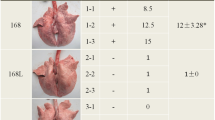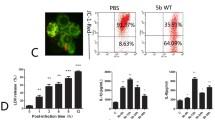Abstract
Mycoplasma hyopneumoniae is an important pathogen of pigs causing enzootic pneumonia of swine. The pathogen remains largely enigmatic as far as the host-pathogen interactions are concerned. In the present study, the protein profiles of two strains of M. hyopneumoniae were compared by two-dimensional gel electrophoresis and mass spectrometry. The results indicate that the major adhesin P97, the 50-kDa protein derived from P159 adhesin, and the 43-kDa cleavage product of P102 are expressed at much higher levels in the pathogenic strain 232. In contrast, the avirulent strain J switches its focus to metabolism and expresses more glyceraldehyde 3-phosphate dehydrogenase in gluconeogenesis and lactate dehydrogenase, pyruvate dehydrogenase, and phosphate acetyltransferase in the pyruvate metabolism pathway. We speculate that the avirulent strain may have developed better capabilities to cope with the rich environment during repeated inoculations. Simultaneously, the capability to infect host cells may become less important so that the adhesion-related protein genes are down-regulated.
Similar content being viewed by others
Abbreviations
- 2D-PAGE:
-
two-dimensional gel electrophoresis in polyacrylamide gel
- IEF:
-
isoelectric focusing
- MS:
-
mass spectrometry
References
Razin, S., Yogev, D., and Nato, Y. (1998) Mol. Biol. Rev., 62, 1094–1156.
Almagor, M., Kahane, I., Gilon, C., and Yatziv, S. (1996) Infect. Immun., 52, 240–244.
Izutsu, K. T., Fatherazi, S., Belton, C. M., Oda, D., Cartwright, F. D., and Kenny, G. E. (1996) In vitro Cell Dev. Biol. Anim., 32, 361–365.
Debey, M. C., and Ross, R. F. (1994) Infect. Immun., 62, 5312–5318.
Burnett, T. A., Dinkla, K., Rohde, M., Chhatwal, G. S., Uphoff, C., Srivastava, M., Cordwell, S. J., Geary, S., Liao, X., Minion, F. C., Walker, M. J., and Djordjevic, S. P. (2006) Mol. Microbiol., 60, 669–686.
Zhang, Q., Young, T. F., and Ross, R. F. (1995) Infect. Immun., 63, 1013–1019.
Zhang, Q., Young, T. F., and Ross, R. F. (1994) Infect. Immun., 62, 1616–1622.
Zielinski, G. C., and Ross, R. F. (1990) Am. J. Vet. Res., 51, 344–348.
Young, T. F., Thacker, E. T., Erickson, E. Z., and Ross, R. F. (1999) Vet. Microbiol., 71, 269–279.
Bereiter, M., Young, T. F., Joo, H. S., and Ross, R. F. (1990) Vet. Microbiol., 25, 177–192.
Muhlradt, P. F., Kiess, M., Meyer, H., Sussmuth, R., and Jung, G. (1998) Infect. Immun., 66, 4804–4810.
Shevchenko, A., Wilm, M., Vorm, O., and Mann, M. (1996) Anal. Chem., 68, 850–858.
Minion, F. C., Lefkowitz, E. J., Madsen, M. L., Cleary, B. J., Swartzell, S. M., and Mahairas, G. G. (2004) J. Bacteriol., 186, 7123–7133.
Vasconcelos, A. T., Ferreira, H. B., et al. (2005) J. Bacteriol., 187, 5568–5577.
Hsu, T., Artiushin, S., and Minion, F. C. (1997) J. Bacteriol., 179, 1317–1323.
Wilton, J. L., Scarman, A. L., Walker, M. J., and Djordjevic, S. P. (1998) Microbiology, 144, 1931–1943.
Djordjevic, S. P., Cordwell, S. J., Djordjevic, M., Wilton, A. J., and Minion, F. C. (2004) Infect. Immun., 72, 2791–2802.
Adams, C., Pitzer, J., and Minion, F. C. (2005) Infect. Immun., 73, 7784–7787.
Nicolet, J., Paroz, P., and Kristensen, B. (1980) J. Gen. Microbiol., 119, 17–26.
Pinto, P. M., Chemale, G., de Castro, L. A., Costa, A. P., Kich, J. D., Vainstein, M. H., Zaha, A., and Ferreira, H. B. (2007) Vet. Microbiol., 121, 83–93.
Author information
Authors and Affiliations
Corresponding author
Additional information
Published in Russian in Biokhimiya, 2009, Vol. 74, No. 2, pp. 264–271.
Rights and permissions
About this article
Cite this article
Li, YZ., Ho, YP., Chen, ST. et al. Proteomic comparative analysis of pathogenic strain 232 and avirulent strain J of Mycoplasma hyopneumoniae . Biochemistry Moscow 74, 215–220 (2009). https://doi.org/10.1134/S0006297909020138
Received:
Revised:
Published:
Issue Date:
DOI: https://doi.org/10.1134/S0006297909020138




